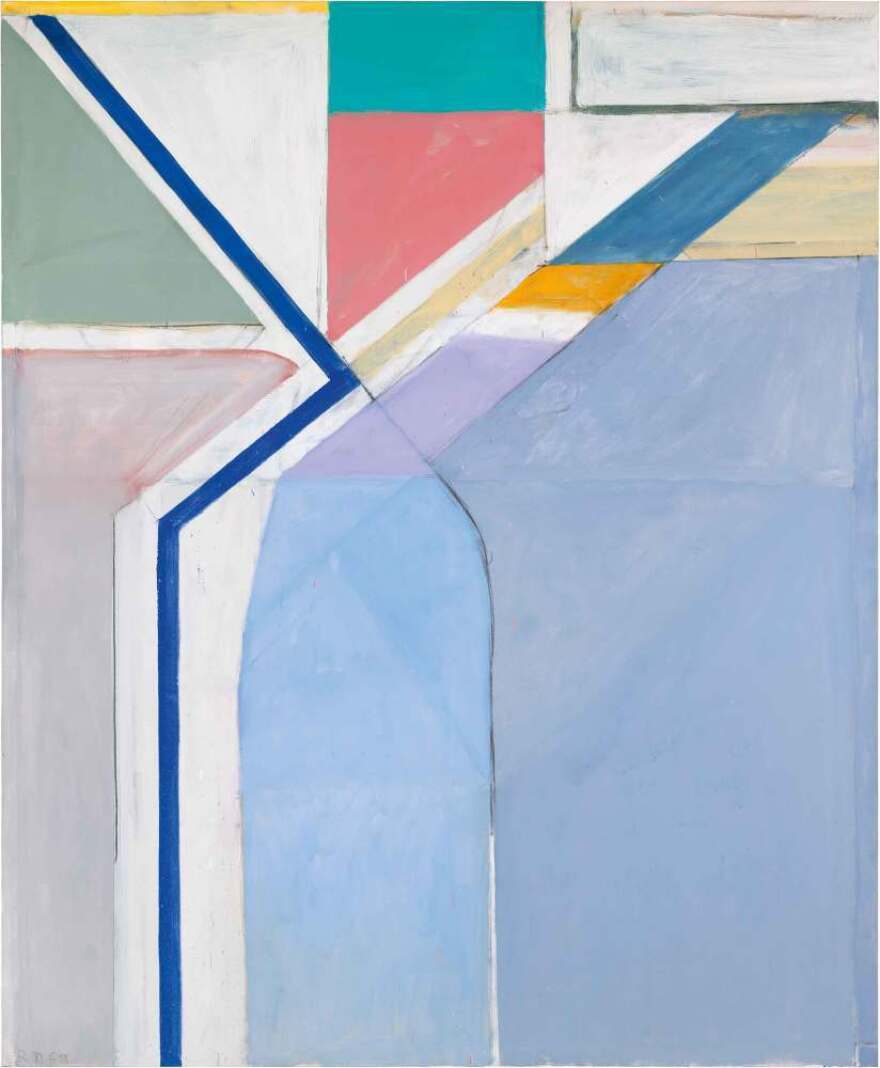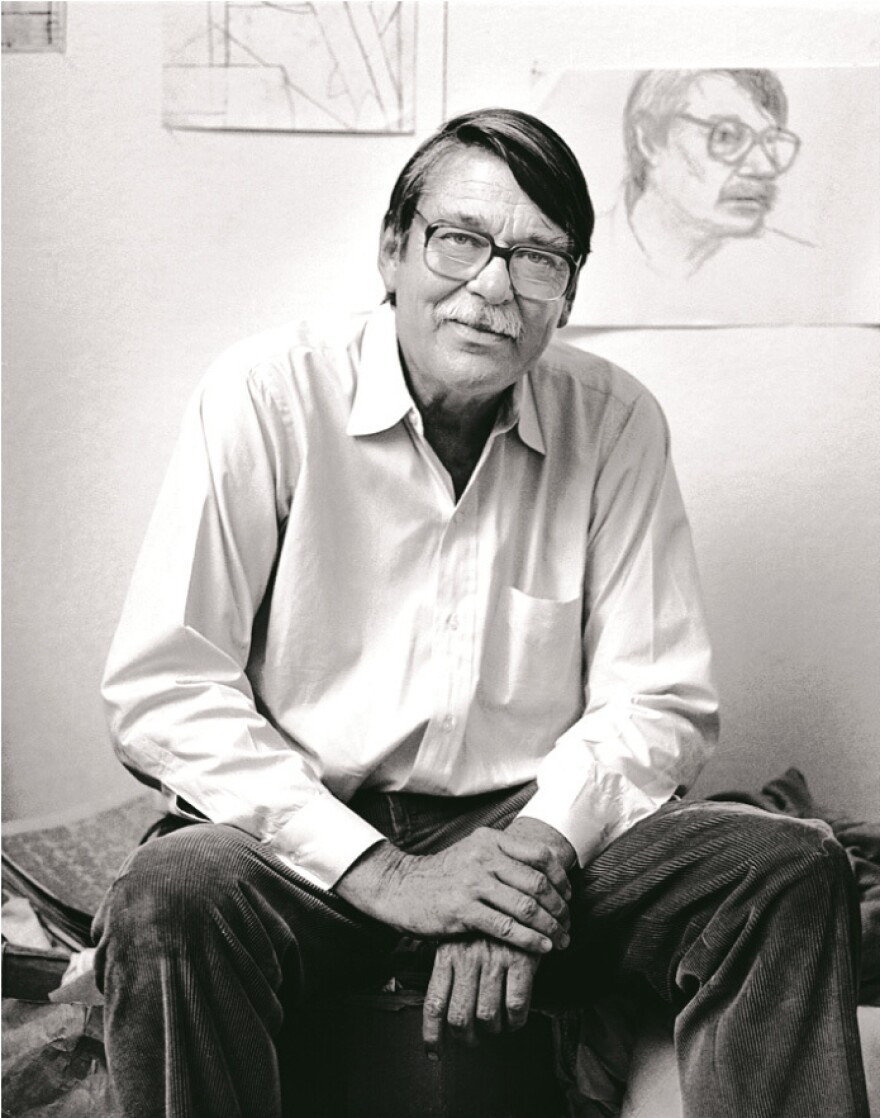In the late 1960s, while America was in turmoil over the Vietnam War and the assassinations of Martin Luther King Jr. and Robert Kennedy, a painter in Santa Monica, Calif., was creating a series of tranquil, glowing canvases that made his reputation and transfixed art lovers. Those works — the Ocean Park series — are now on view at the Orange County Museum of Art, about an hour's drive from the place where they were painted.

Main Street, running through the Ocean Park neighborhood of Santa Monica, is two blocks from the Pacific Ocean. The thoroughfare hums with cars, young families pushing strollers, aging hippies and fancy coffee machines.
Walk a bit, and you'll pass shops, restaurants and beach-y bungalows that can sell for $1 million or more. The Ocean Park you see in 2012 is very different from what it was in 1967, when Richard Diebenkorn began painting his Ocean Park series.
"This was a derelict area," says Kimberly Davis, who directs the L.A. Louver Gallery in nearby Venice Beach. Diebenkorn visited the L.A. Louver every week when he worked in Ocean Park. "There were a lot of artists living there," Davis says.
The reason there were so many artists was that rent was cheap — really cheap. They were living on the edge here. Ocean Park was literally at the edge of the country, but it was also on the edge of the edge of Los Angeles, and painters could afford to live here.
Diebenkorn's first Ocean Park studio, where he began making the big, gently colored, geometric canvases of his series, was on Ashland Avenue. Then he moved to 2448 Main St., where he built his studio. On the outside of the building hangs a plaque: R.D. Studio 1975 to 1988.

The view from one window in Diebenkorn's Main Street studio is now obscured by trees. Once, the hillside was visible. Diebenkorn looked up at the geometry of that hillside, how the streets crossed one another. It may seem counterintuitive that he turned his back on the ocean, but Diebenkorn was more interested in light than water.
The Orange County Museum of Art is now showing the first big retrospective of the Ocean Park series, Diebenkorn's series about light. "I've never verbalized this before, but I see it as a clarion call," says Sarah Bancroft, who curated the exhibit.
Like Diebenkorn, Bancroft is drawn to Santa Monica's pale, soft and seductive light. "I love the light here," she says. "I grew up in Arizona where there is a very harsh yellow light, and the light here is quite different. There is a very airy quality to it."
The light shimmers. Diebenkorn, looking up at the Ocean Park hills through his studio's big windows, didn't paint the landscape; he painted the quality of the light on the landscape, framed by the angled geometry of those windows. He's an abstract painter. His shapes are architectural. His colors — chalky pastel blues, violets, yellows, greens — make the geometry shimmer.

"They're very architectonic," Bancroft says of Diebenkorn's canvases. "But they're also lyrical. That's kind of a dangerous word to use with the work. And yet he was the first to acknowledge that music was so important, and there's a relationship between his work and music."
Diebenkorn played music in the Ocean Park studio as he painted. He particularly loved Bach and Mozart. He worked on his Ocean Park canvases for more than 20 years, producing 145 paintings in the series. Each was numbered chronologically. Bancroft says many of the canvases have ghosts. Ocean Park #79, for example, painted in 1975, features blues, lavenders and aquas, and ghosts of his earlier decisions about color.
"He painted and repainted," says Bancroft. "He would scrape away, paint some more. He would focus on one area and decide he would move onto another and destroy something he had worked on for quite a while because he felt like he was treating it too preciously and he identified it as just wanting to get everything right. Everything right. Light, color, space, volume, the whole composition. But he wasn't afraid to show the mistakes."
Ocean Park #79 is a big canvas — 93 inches by 83 inches — full of little moments. Diebenkorn left little drips while applying paint to this canvas. He incorporated a thin strip of red near the top, guiding the viewer's gaze upward. "They're just gorgeous compositions of color," says Bancroft. "I really do see them as kind of music."
Diebenkorn, who died in 1993, created his Ocean Park series from 1967 to 1988. Through the agonies of Vietnam, the anti-war protests, the resignation of a president, a gas crisis and unremitting change, he painted these incandescent canvases. Bancroft sees in them what she calls a "riotous calm." These are paintings that must be experienced.
"The average viewer spends about 4 seconds looking at a painting, maybe 5 in any museum," says Bancroft. "These paintings, there's so much going on. They're so delicate and beautiful and sumptuous. To truly appreciate them, not only do you need to spend more than 5 seconds with them; it would be ideal if you could spend hours and hours with them."
Copyright 2024 NPR. To see more, visit https://www.npr.org.



